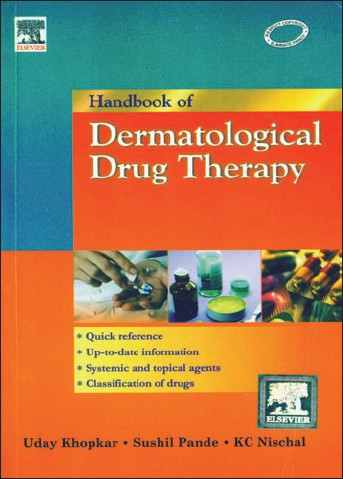Translate this page into:
Handbook of dermatological drug therapy
Correspondence Address:
K K Raja Babu
India
| How to cite this article: Raja Babu K K. Handbook of dermatological drug therapy. Indian J Dermatol Venereol Leprol 2007;73:282 |
 |
| Figure 1 |
 |
| Figure 1 |
Uday Khopkar, Sushil Pande, K. C. Nischal
Publisher : Elsevier India Publications, First Edition, 2007
Pages: 480, Cost: INR. 295
The Handbook of Dermatological Drug Therapy is a welcome addition to the growing list of cute little books on this subject. This book is extra endearing. Nicely designed and excellently printed, the handbook is a visual delight. Written in simple, lucid style in free-flowing English, the text is eminently readable.
Although the book is basically targeted to dermatologists-in-training to help them with their daily duties and the inescapable examinations, it could very well be a ready reckoner for a busy practicing dermatologist. The book is organized into two sections: Section 1 dealing with commonly used systemic drugs and Section 2 dealing with topical agents frequently used in dermatological practice. There are special chapters on dermal fillers and botulinum toxin. A special attraction of the book, indeed a bonus, is the appendix section, which deals with office aids and commonly used instruments in dermatological practice (with nice line diagrams) as well as various apparatuses employed in treating patients suffering from skin disorders.
Bullet and numbered-point text makes for easy reading and memorizing. Particularly helpful for practice are ′key points′ outlined for each drug. A small box highlighting the mechanism(s) of action for every drug is another positive attribute. Each drug also carries a FDA pregnancy category rating. All in all, the book strikes a careful balance between what is known about a drug and what the targeted reader ought to know. There are also a good number of tables that help the reader who is looking for some quick information. There are some exceptional ′pearls′ as well. That a common pin has so many dermatological uses, I never knew!
I tried hard to do some nit-picking but couldn′t succeed. One omission perhaps is that of M. chelonei and M. fortuitum infections in the table on treatment regimens for atypical mycobacterial infections-the most important atypical mycobacterioses in current dermatological practice.
This book should not only be a constant companion to every resident training in dermatology and every practicing dermatologist but also it should be on the shelf of every medical department of every hospital, small or big. The search for a nice pocket-sized dermatological therapy book should end here for now.
Fulltext Views
11,148
PDF downloads
4,091





